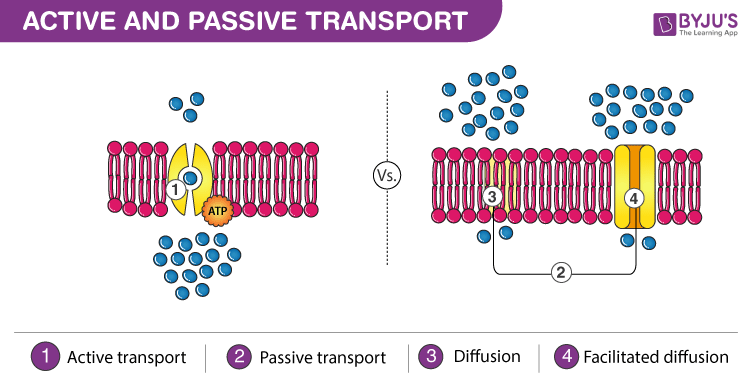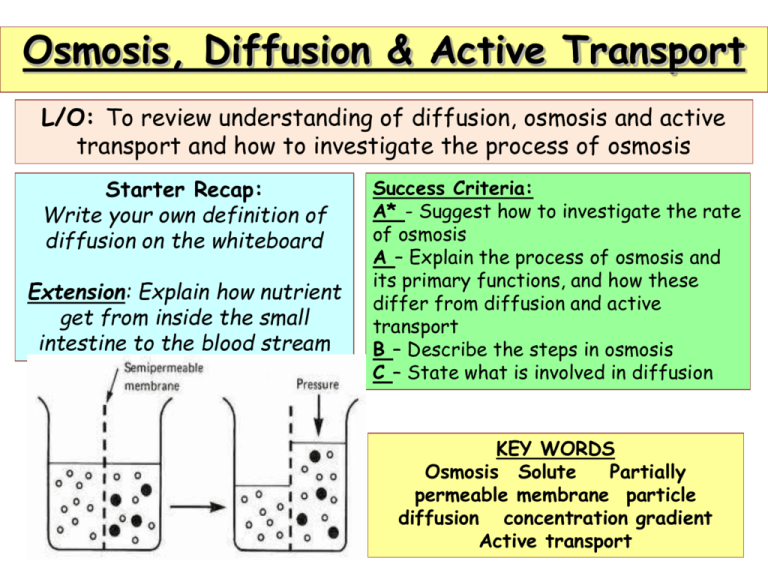Explain How Active Transport Differs From Diffusion.
We use simple diffusion to allow carbon dioxide and oxygen go in and out of our cells without the use of energy. Discuss the physiological significance of the NaK pumps.
Difference Between Diffusion And Active Transport Definition Types Process Similarities
Active transport requires chemical energy because it is the movement of biochemicals from areas of lower concentration to areas of higher concentration.
. Active transport takes place toward the gradient of concentration. Molecules can diffuse across membranes through the phospholipid bilayer or using a special protein. Explain how facilitated diffusion differs from diffusion in general.
Facilitated diffusion does not require energy to transport molecules. In active transport the molecules move against the concentration gradient whereas in passive transport the molecules move along the concentration gradient. In secondary active transport the electrochemical gradient is used to transport molecules across the membrane.
Compare and contrast diffusion and osmosis. Explain how active transport differs from facilitated diffusion. Is the movement of molecules ions from a region of higher to lower concentrationIt may or may not occur across a semi permeable membrane.
Either kind of diffusion does not need energy from the cell. Comparing diffusion osmosis and active transport. On the other hand passive trasport moves biochemicals from areas of high concentration to.
Active transport is a mechanism of transporting molecules across the cell membrane by utilizing the energy produced through respiration. Active transport requires energy to transport molecules across the membrane. Some special proteins move certain molecules across cell membranes only with the help of.
Active and passive transport are biological processes that move oxygen water and nutrients into cells and remove waste products. Different channel proteins facilitate the diffusion of different charged particles what does active transport do uses energy to move molecules and ions across the membrane against a concentration gradient. Membrane pumps w energy provided by ATP do this.
List the three characteristics of facilitated diffusion that distinguish it from simple diffusion. Related to Essential Skill 3-4 2. An active method is an active transport.
Describe active transport including primary and secondary active transport in your description. Related to Essential Skill 3-4 4. Diffusion is the movement of particles from a high concentration to a low concentration.
In contrast diffusion refers to the passive transport method where the molecules move across the cell membrane through a concentration gradient. Simple diffusion facilitated diffusion osmosis and filtration are examples of passive transport. Although other transport processes do occur diffusion is the key player.
Related to Essential Skill 3-4 3. Thus ATP energy is required for active transport but in diffusion substances move passively along a concentration gradient and it does not involve ATP energy. The main difference between diffusion and active transport is that diffusion is a passive transport method in which molecules move across the cell membrane through a concentration gradient whereas active transport requires cellular energy in order to transport molecules against the concentration gradient.
In animals plants and microorganisms substances move into and out of cells by diffusion osmosis and active transport. Active transport is the movement of molecules from an area of low concentration to an area of high concentration so against the concentration gradient. The facilitated diffusion is faster than simple diffusion but as the concentration of the transported substance increases the carrier is saturated and the rate of facilitated diffusion stops increasing.
Describe and give an example of diffusion. Solutions for Chapter 6 Problem 7CP. In active transport substances move against a concentration gradient.
Draw a figure that illustrates two of the characteristics of carrier-mediated transport and explain how this type of movement differs from simple diffusion. June 27 2011 Posted by DrSamanthi. The carriers as in the active transport are proteins embedded in the cell membrane.
An example of diffusion is oxygen moving from the airways to the lungs - there is very little oxygen in the lungs but lots in the air. Examples of diffusion include the scent of perfume filling a whole room and the movement of small molecules across a cell membrane. From a lower concentration region to a higher concentration region.
In diffusion there is no challenge involved as it is along the concentration gradient but in active transport movement of molecules occur against concentration gradient ie. What is the difference between Active Transport and Diffusion. Passive diffusion also allows small non-polar molecules or substances to travel across the membrane.
Active transport uses proteins from the carrier. Hence unlike passive diffusion this process demands energy. And this process occurs against the concentration gradient.
In primary active transport ATP is used in form of the energy. In diffusion molecules move down their gradient while in active transport molecules move against their gradient which requires energy. Diffusion is the movement from a high concentration of molecules to a low concentration of molecules.
List the three characteristics of facilitated diffusion that distinguish it from simple diffusion. ATP gives up a phosphate group to a transport protein the chemical for the solute the protein improves on 1 side of the membrane solute bounds at site protein shape changes. Uptake of glucose in the human intestine works on the principle of active transport.
Thus energy is needed. The key difference between active transport and facilitated diffusion is that the active transport occurs against the concentration gradient hence utilizes energy to transport molecules across the membrane while the facilitated diffusion occurs along the concentration gradient hence does not utilize energy to transport. One of the simplest demonstrations of diffusion is adding a drop of food coloring to water.
Examples of Diffusion. The primary difference between active transport and diffusion is that active transport needs cellular energy to transport the molecules against the concentration gradient. Nutrients are concentrated into the cell with the help of active transport.
From lower to higher concentration. Active transport is the movement of particles from an area of low concentration to an area of high concentration. This process does not require energy.
Active transport occurs against the concentration gradient. Facilitated diffusion is a passive method and needs no energy. In transportation facilitated diffusion uses both gated channel proteins and carrier proteins.

Difference Between Active Transport And Passive Transport
Difference Between Facilitated Diffusion And Active Transport Definition Mechanism Function

No comments for "Explain How Active Transport Differs From Diffusion."
Post a Comment